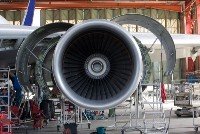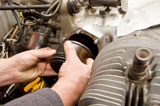|
Required Aircraft InspectionsRegular aircraft inspections are necessary to maintain the continued airworthiness of any aircraft.
When a new aircraft is being designed and produced, the aviation authority, the manufacturer, and selected industry participants form groups called maintenance steering groups (MSG) and industry steering committees (ISC). These groups, through numerous meetings determine the frequency and scope of aircraft inspections to be peformed. This information is provided to another group called the maintenance review board (MRB). The MRB will issue their final recommendations to the manufacturer on how an aircraft should be maintained. The manufacturer then publishes this information in maintenance planning documents to be provided to the customer. For small private aircraft the aircraft owner usually follows the inspections and maintenance practices published by the manufacturer. For airline or commercial operators, the recommendations of the MRB are used to develop a Continuous Airworthiness Maintenance Program (CAMP), which is then approved by the FAA. The CAMP outlines the amount of time between aircraft inspections and how often aircraft components need to be inspected, overhauled or replaced. 
Based on an operators experience, they can apply to the FAA for an adjustment of maintenance and inspection intervals. Though there are different standards for the different periodic inspections, they collectively cover the entire aircraft and aircraft components over a period of time. This includes inspecting the fuselage, wings, tail, landing gear and wheel well, engines, communications systems, instruments, electrical components, and other areas. Important items on an inspectors list include looking for signs of corrosion and metal fatigue, as well as leaking or faulty components. FAR Part 91 requires the inspection of all civil aircraft at specific intervals to determine the overall condition. Those intervals are based on the type of operation the aircraft is used for. The aircraft must also be maintained in an airworthy condition (referred to as continued airworthiness) between those required inspections. Most small aircraft need to be inspected after each 100 hours of operation with at least one inspection each 12-calendar months. Some owners elect to inspect their aircraft in accordance with an inspection system set up to provide for total inspection of the aircraft on the basis of calendar time, time in service, number of system operations, or any combination of these. All inspections should follow the current manufacturer's maintenance manual, including the Instructions for Continued Airworthiness concerning inspection intervals, parts replacement, and life-limited items as applicable to the aircraft. Large Aircraft ChecksWhile all aircraft have periodic inspections, large aircraft have to go through an extensive inspection process, also referred to as “checks.” There are several checks that need to be done according to calendar dates, flight hours, or flight cycles. A flight cycle is one flight, with a take-off and landing. The manufacturer determines what each check will be called, but the following are typical checks using letters to identify them. An A-check is a light routine inspection. On the opposite end of the spectrum, a D-check is the most intensive, long-term check.
For more information and updates regarding aircraft inspections, sign-up for our free Newsletter. |
|
|
||







